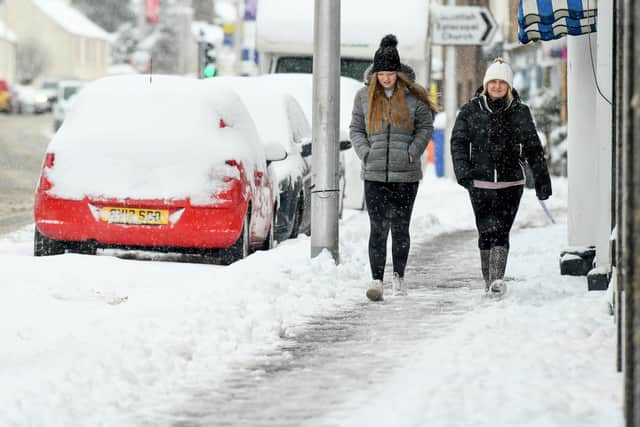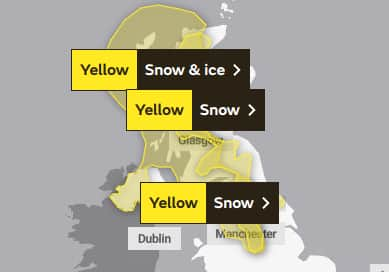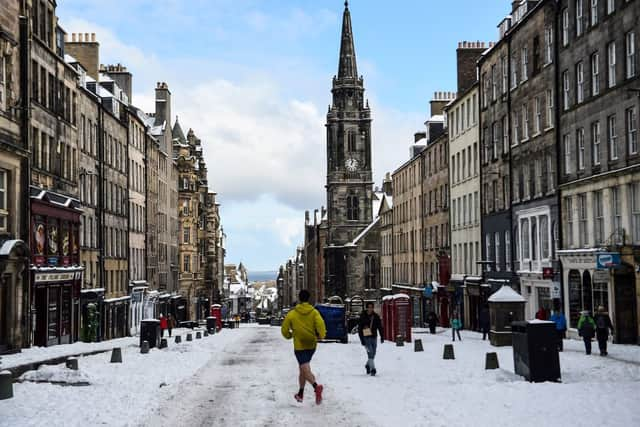Weather forecast: Met Office yellow weather warnings for snow and ice explained as UK warned of ‘thundersnow’
This article contains affiliate links. We may earn a small commission on items purchased through this article, but that does not affect our editorial judgement.
and live on Freeview channel 276
Thundersnow could hit Scotland, forecasters have warned, as they said snow showers and lightning strikes could see homes knocked off the power grid, with yellow weather warnings for snow and ice issued for parts of northern England and Scotland on Thursday.
The Met Office has warned of dangerous weather conditions, predicting that there could be as much as 10cm of snow falling on the highest ground, as well as the risk of dangerous icy patches and of lightning strikes from isolated thunderstorms.
This is what you need to know.
What has the Met Office said?
Advertisement
Hide AdAdvertisement
Hide AdThe Met Office has predicted snowfall in areas including Greater Manchester, Lancashire, Cumbria, Merseyside, Yorkshire and Scotland, between 10am and 4pm on Thursday 6 January, followed by freezing conditions in the evening and wintry showers into Friday.
Met Office spokesman Grahame Madge said: “As we go into the overnight period temperatures will start to drop and in some of the sheltered glens in Scotland we could see minus 10 (Celsius) or even colder temperatures recorded.
“Across the UK there is not going to be many places that will remain above freezing.
“[On Thursday] we will start to get this weather front coming in from the west.
Advertisement
Hide AdAdvertisement
Hide Ad“We are going to see that moisture-laden air coming in, bumping into this cold air and whenever you get that you tend to get transient snow. It’s likely to last for one or two hours.”


The forecaster added that the prospect of thundersnow was driven by the same conditions which cause thunder in the summer, the difference in temperature between the ground and the air surrounding it.
“Because you have got that differential it’s possible, quite easily, for warm air at ground level when it heats up to start to rise very quickly up through the cold air and that’s what creates the potential for thunderstorms, so we are likely to see along with the other wintry showers, likely to see hail and snow,” he said.
While frequent wintry showers during Thursday evening and overnight are likely to lead to a fresh covering of snow for areas above 200 metres, forecasters have predicted much milder conditions going into the weekend.
Advertisement
Hide AdAdvertisement
Hide AdMadge added: “Friday into Saturday we have got another frontal system moving across the UK. That’s more likely to deliver rain more widely.
“By Saturday and into the weekend any wintry showers are likely to be just over the higher tops and fells.”
What weather warnings are in place?
Yellow weather warnings for snow and ice have been issued by the Met Office across Thursday 6 and Friday 7 January.
The warnings cover large areas of the west of Scotland, as well as locations in northern England.


Advertisement
Hide AdAdvertisement
Hide AdRegarding the yellow weather warning for snow and ice, the Met Office says that “frequent sleet, hail and snow showers may lead to some disruption to travel”.
The weather service says you should expect:
- Some roads and railways to be affected with longer journey times by road, bus and train services
- Some icy patches on some untreated roads, pavements and cycle paths
- Some brief power outages with the risk of isolated lightning strikes
- Some injuries from slips and falls on icy surfaces
What is thundersnow?
Thundersnow is a rare weather phenomenon which occurs when thunderstorms form in wintry conditions which can sometimes give rise to heavy downpours of snow.
According to the Met Office, thundersnow can “only occur in a few months of the year”.
The lightning during thundersnow appears brighter than regular lightning because the light reflects off of the snowflakes.
Advertisement
Hide AdAdvertisement
Hide AdThe Met Office says: “Interestingly, the snow contained within the thunderstorm acts to dampen the sound of the thunder.
“While the thunder from a typical thunderstorm might be heard many miles away, the thunder during a thundersnow event will only be heard if you are within two to three miles of the lightning.”


In December 2020, Scottish capital Edinburgh experienced thundersnow at around 4:40am, with residents being awoken to loud bangs and bright flashes.
At the time, Police Scotland received calls from concerned members of the public who thought that the sound could have been explosions.
Advertisement
Hide AdAdvertisement
Hide AdPolice Scotland tweeted shortly after the thundersnow, at 5:03am: “We have received a number of calls regarding people concerned about explosions heard.
“Please do not be alarmed, we are currently experiencing thunder and lightning.”
A message from the editor: Thank you for reading. NationalWorld is a new national news brand, produced by a team of journalists, editors, video producers and designers who live and work across the UK. Find out more about who’s who in the team, and our editorial values. We want to start a community among our readers, so please follow us on Facebook, Twitter and Instagram, and keep the conversation going. You can also sign up to our newsletters and get a curated selection of our best reads to your inbox every day.
Comment Guidelines
National World encourages reader discussion on our stories. User feedback, insights and back-and-forth exchanges add a rich layer of context to reporting. Please review our Community Guidelines before commenting.
